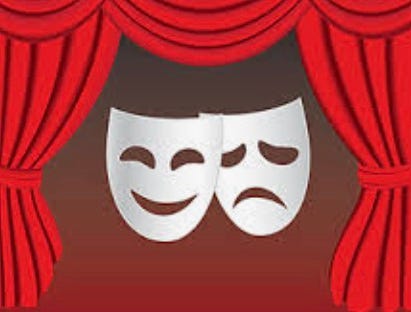Theater Kids Rule!
A recent New York Times piece cited the perhaps surprising frequency with which so-called “theater kids” occupy lead roles in a surprising range of vocations and avocations. As the article notes, the skills and collaboration developed in theater are superb preparation for life and work.
It was a convincing and compelling argument for arts education, but omitted the most powerful impact on learning and life. Too many analyses of educational impacts are based on earning power or conspicuous achievement. By far, the greatest benefit of the arts and arts education is the development of empathy and understanding. I wrote this piece for Huffington Post a few years ago:
The ten or so "seniors" entering the Calhoun School's theater on Monday afternoon were greeted with a round of cheers by the fourth grade; it wasn't their first encounter. These were not high school seniors, but a group of Upper Westside Manhattan residents from a Senior Center down the street who came to watch a set of brief performances.
Our fourth graders and their older friends became acquainted through Calhoun's community service program. As with any good community engagement, our relationship with this Center is not an act of charity or noblesse oblige on the part of a wealthy private school and its privileged students. To the contrary, through these kinds of relationships we receive far more than we give.
Fourth grade teachers extended this relationship into a piece of exemplary curriculum. Our elder neighbors were invited to write stories of their own childhood – focusing on when they themselves were approximately 10, the age of our students. Our teachers and students then carefully crafted their stories into short plays. The students played all the parts, including as the stories' narrators. The once 10-year-olds, now our octogenarian and nonagenarian friends, were seated in the front rows of our theater.
It was a delightful hour. The students' performances ranged from blushing innocence to soaring eloquence (and frequent irreverence). There were no sets or fancy costumes. It was mighty endearing; fourth graders make my heart melt. Of course, second graders and 11th graders make my heart melt too, so maybe I'm not the most dispassionate critic.
The stories were highly varied, capturing the innocence of a first kiss, evoking the day that Hitler invaded Poland, or expressing the universal thrill of childhood anticipation as a girl anxiously awaited a longed-for gift of a doll.
A particularly poignant piece illustrated the reality of life for immigrant families in New York City in the early 20th century. A girl and her younger sister went forth too boldly into their new neighborhood where they knew neither the language nor the streets and became hopelessly lost and terrified. They were guided safely home by the kind attention of a nameless neighbor in their strange new country.
I needn't elaborate on the elder friends' reactions to the performance – you might imagine. There were laughs and tears; they were on the edge of their seats. After the performance, the actors and the audience enjoyed platters of cookies with milk. Their mutual affection was very, very real.
It is easy to like this and equally easy to underestimate its power. The student performances required empathy, as does all good theater. These fourth graders became immigrant children lost in an overwhelming city. They inhabited another world and another time. They learned what was different then, but, far more importantly, they learned what was the same. They learned that the gray, wrinkly friends in the front rows were once kids, just like them, with the same fears, hopes, and silly senses of humor. They realized that the distance between 10 and 90 is only an arm's length, if you open your heart and mind.
In the test-obsessed environment driven by current public policy, along with persistent attacks on teachers, what teacher could risk taking time to do something like this?
Teachers with 30 kids in the classroom can't do it. Teachers who are told to use more technology so that they can "deliver content" with more furious efficiency can't do it. Teachers who are handed a dull script about the day's state standard can't do it. The teachers whose jobs and lives are dependent on raising test scores can't do it. The teachers of earnest little fourth graders in charter schools, lined up in their blazers and skirts, certainly can't or won't do it.
Those teachers don't have time for giggles. They can't pause long enough for their students to share milk and cookies with 85-year-olds who they never imagined to have had a first kiss or gotten lost and confused, just as they have been. There isn't time to learn that World War II was not just an event in a textbook, but was a real experience that deeply affected the lives of children who loved beautiful dolls or dreamt of building perfect igloos.
This one experience provided more real learning than months of preparation for a test, whose questions and answers are sure to be forgotten by the next week. The fourth grade students in this project and their neighborhood friends will never forget it. Nor will I.




